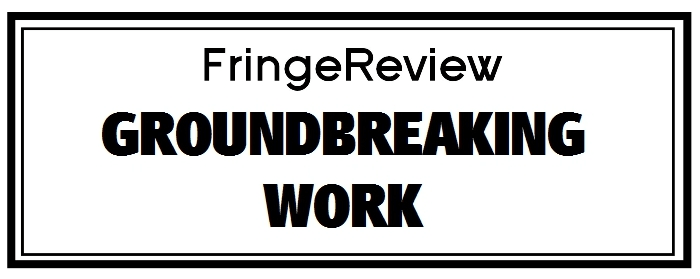FringeReview UK 2019
Berberian Sound Studio
Donmar Warehouse

Genre: Adaptation, Drama, Experimental, Immersive, Mainstream Theatre, New Writing, Short Plays, Theatre
Venue: Donmar Warehouse
Festival: FringeReview UK
Low Down
Joel Horwood’s adaptation of Peter Strickland’s 2012 Berberian Sound Studio is conceived for the Donmar by Horwood and designer Tom Scutt who co-designs a naturalistic sound studio with Anna Yates. The story amplifies through Ben and Max Ringham’s virtuosic sound design. Lee Curran’s lighting makes use of chiaroscuro, so mostly were plunged in darkness lit by shadows.
Review
It’s only for good reasons you’d find the Donmar involved in a stage adaptation of a movie. Aural ones in fact, since it’s sound that holds the stage in Joel Horwood’s adaptation of Peter Strickland’s 2012 Berberian Sound Studio.
Part-homage to Italian Giallo 1970s horror films, it’s a bit like Michael Frayn’s Noises Off – indeed noises are key – except it’s not a comedy and we never see the movie: a complete exo-skeletal flip. Italians routinely shot films silently then dubbed, often in different languages for the international market. This work references that convention.
Conceived for the stage by Horwood and designer Tom Scutt who co-designs a naturalistic sound studio (complete with worn-down floor, cumbersome trolleys) with Anna Yates, the story amplifies through Ben and Max Ringham’s virtuosic sound design. Lee Curran’s lighting makes use of chiaroscuro: so often we’re plunged in darkness, lit by shadows.
This added character creeps up on you or round the back of the audience. There’s a tenebrous unease lit with sound booths suddenly flaring up where actors scream with bad coughs or a hostile producer and receptionist make life difficult: for Tom Brooke’s British sound engineer, the actors, each other.
We’re in post-production where Brooke’s Gilderoy has been invited over by director Santini (Luke Pasqualino) to work on his film’s sound effects. It’s not a horror, it’s art, smooth Santini tells him, but it’s mainly contemptuous producer Francesco (Enzo Cilenti) he has to deal with.
Hostility builds and Gilderoy has to decide where on the aural spectrum he is. It’s ultimately about complicity, that exo-skeletal structure a trope for male bullying.
Gilderoy’s a kind of David Attenborough sound-geek, recording chaffinches. You almost feel he’s like the wrong reporter Boot in Evelyn Waugh’s Scoop (nature writer sent to warzone). Quite why he’s been plucked from this genre remains mysterious but one can guess.
Throughout, two women actors are roundly abused. The screen actors’ voices deemed ‘unsuitable’ – a kind of vocal airbrushing – vocal actors are chosen to dub them. When Lara Rossi’s Sylvia, picked out as the heroine, begins coughing, Beatrice Scirocchi’s Carla the second actor is swapped. Sylvia warns Gilderoy but also looks to him to protect her position and the integrity as he sees it of her voicing. His copy of the script differs from hers. And Gilderoy’s drawn into himself creating the ‘Foley’ effects of snapped celery and other torture sounds. The nature of the film’s occluded from each participant, and you have to take sides.
Brooke’s out-of-Dorking baffled abroad is gawk personified. Already bounced frostily through departments (that’s Eugenia Caruso’s Elena) to reclaim his hefty flight expenses he feels obliged to stick to his lack of a script or end seriously out of pocket. The script’s in Italian, the English one never arrives. Caruso incidentally played the original ‘screamer’ film actor, here called Carla. That several actors are Italian is another key: unless you’re fluent the rapid-fire ferocity becomes another aural event, a meta-language literally over Gilderoy’s – and our – heads. And there’s Loré Lixenberg’s Lixenberg who exudes an operatic calm.
To amplify the experience there’s two silent Foley-workers called Massimo – who chop cabbages, carrots, watermelons (messily smashed, one piece handed to Gilderoy). Tom Espiner and Hemi Yeroham’s choreographed dance is joined by stick-wielding Sidney Kean’s Lorenzo, a curiously menacing figure who appears in half-gloaming. It’s like Berlin-noir with a Roman accent.
Against all this Gilderoy’s set up his progressively blinded mum, Marion Bailey’s voice with chaffinches narrating a reel from Dorking played at 3am. It both heightens his isolation, then Dorking darkens too.
This aural oppression snatches integrity from the spliced end, as Brooke’s character overdubs it. How innocent people are drawn into complicit actions might be at the heart of the film (which I’ve not seen), but this production’s clearly conceived in the shadow of #metoo, and rightly highlights that fallout; the actors’ appeal to Gilderoy as a disinterested outsider is freighted with a sharper awareness of what this means for women.
Though Brooke’s central to this shadowy kaleidoscope of sound and dimness, it’s an ensemble immersion where everyone moves out of a tableau-vivant to ask questions. Thoroughly absorbing, it’s full of walking shadows who throw vivid questions.


















































